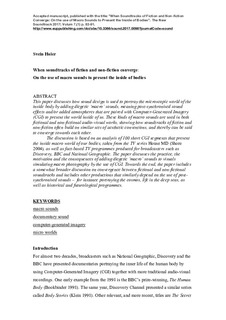| dc.contributor.author | Høier, Svein | |
| dc.date.accessioned | 2017-11-10T08:01:12Z | |
| dc.date.available | 2017-11-10T08:01:12Z | |
| dc.date.created | 2017-02-26T08:06:26Z | |
| dc.date.issued | 2017 | |
| dc.identifier.citation | The New Soundtrack. 2017, 7 (1), 83-91. | nb_NO |
| dc.identifier.issn | 2042-8855 | |
| dc.identifier.uri | http://hdl.handle.net/11250/2465420 | |
| dc.description.abstract | This paper discusses how sound design is used to portray the microscopic world of inside the human body by adding diegetic ‘macro’ sounds, meaning post-synchronised sound effects and/or added atmospheres that are paired with Computer-Generated Imagery (CGI) to present the world inside us. These kinds of macro sounds are used in both fictional and non-fictional audio-visual works, showing how soundtracks of fiction and non-fiction often build on similar sets of aesthetic conventions, and thereby can be said to converge towards each other.
The discussion is based on an analysis of 100 short CGI segments that present the macro world inside our bodies, taken from the TV series House MD (Shore 2004), as well as fact-based TV programmes produced for broadcasters such as Discovery, BBC and National Geographic. The paper discusses the practice, the motivation and the consequences of adding diegetic ‘macro’ sounds to visuals simulating macro photography by the use of CGI. Towards the end, the paper includes a somewhat broader discussion on convergence between fictional and non-fictional soundtracks and includes other productions that similarly depend on the use of post-synchronised sounds – for instance portraying the cosmos, life in the deep seas, as well as historical and futurological programmes. | nb_NO |
| dc.language.iso | eng | nb_NO |
| dc.publisher | Edinburgh University Press | nb_NO |
| dc.title | When Soundtracks of Fiction and Non-fiction Converge: On the use of Macro Sounds to Present the Inside of Bodies | nb_NO |
| dc.type | Journal article | nb_NO |
| dc.type | Peer reviewed | nb_NO |
| dc.description.version | acceptedVersion | nb_NO |
| dc.source.pagenumber | 83-91 | nb_NO |
| dc.source.volume | 7 | nb_NO |
| dc.source.journal | The New Soundtrack | nb_NO |
| dc.source.issue | 1 | nb_NO |
| dc.identifier.doi | 10.3366/sound.2017.0098 | |
| dc.identifier.cristin | 1453967 | |
| dc.description.localcode | This is an Accepted Manuscript of an article published by Edinburgh University Press, available at http://www.euppublishing.com/doi/10.3366/sound.2017.0098 | nb_NO |
| cristin.unitcode | 194,62,35,0 | |
| cristin.unitname | Institutt for kunst- og medievitenskap | |
| cristin.ispublished | true | |
| cristin.fulltext | postprint | |
| cristin.qualitycode | 1 | |
